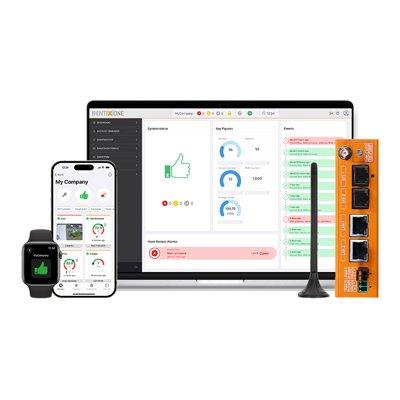 |
| Krosno city center square, with video surveillance and hotspot over wireless infrastructure |
The challenge
To quickly build an effective network, taking into account Krosno limitations on cost, deployment time, and strict regulations prohibiting digging and trenching in the heart of the city. A wireless network was the obvious answer, particularly since Krosno was given ten 3.5 MHz channels in the 3.5 GHz band as part of the Polish government's efforts to encourage telecom development. Evaluations of wireless networks started in 2004 to find the vendor providing the best service and offering equipment certified by the WiMAX Forum® and field-proven to withstand the Arctic-like Krosno winter temperatures, which can reach -30ºC with winds up to 180 km/hour.
The solution
Alvarion's initial network in Krosno, comprised of one, four-sector BreezeMAX® macro base station used to provide broadband services to 13 schools, went live in 2006. Municipal officials soon saw the enormous flexibility of the ubiquitous network, and quickly started using it for the delivery of an entirely new video surveillance solution to the local police force.
By adding two sectors to each base station and attaching a CPE to each camera, Alvarion's network now links five cameras in the city centre and two cameras in the grounds of schools, streaming images at speeds of up to 3 Mbps. Additionally, the solution includes a nomadic camera attached to a police vehicle, which sends images back to the control rooms immediately from the scene of an incident.
 |
| Sectors of the wireless network with view over Krosno's periphery - old town and new parts of the city |
Following the successes of this CCTV project, Krosno has further extended the network to provide data access to various administrative buildings, as well as offering hotspots in six locations across the city. The local utility company (responsible for fresh water, waste water and sewage) also uses the network to interconnect buildings with data and VoIP, as well as support monitoring and control by connecting supervisory control and data acquisition (SCADA) equipment.
The Result
Krosno is just one of many municipalities and operators around the world that entered into the WiMAX world with defined targets and then realized that WiMAX networks can be utilized for a range of other activities. Quick and relatively inexpensive to build and operate, WiMAX is an ideal solution to reach areas not covered by existing wired infrastructure. Furthermore, as seen in the Krosno story, WiMAX networks can be easily expanded to high demand areas and enable the fast connection of new customers.
For Krosno, future plans for their WiMAX network include:
- Extending the e-education deployment to cover all 35 schools, all kindergartens and libraries in the city.
- Providing VOIP services to enable free internal calls between all administration and education buildings.
- Extending support to up to 30 hotspots and providing municipal content over this free network.
- Introducing a two-tier voice and data residential access service offering basic services free of charge and extended services for a fee.
Learn why leading casinos are upgrading to smarter, faster, and more compliant systems




















